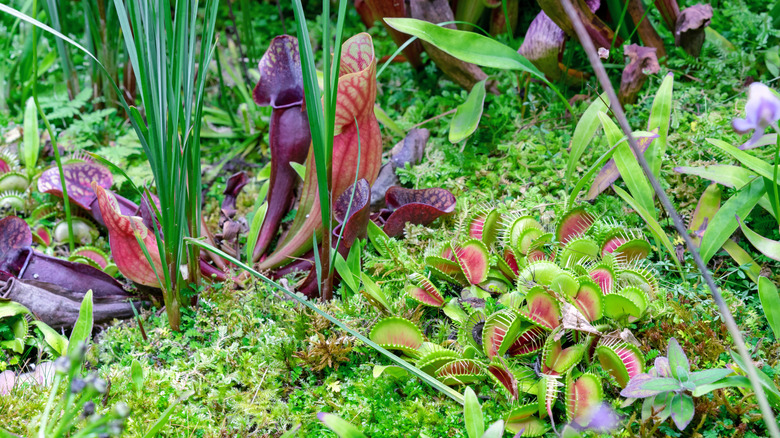The Exotic Garden Trend You'll Be Seeing More In 2025
Pop culture is all about trends, and gardens are no exception. Whether it's the rise of pollinator-friendly backyards or therapeutic green spaces, garden trends are constantly entering and exiting the stage. A new trend that's becoming more popular is adding carnivorous plants, plants that actually eat bugs in real life, to garden spaces. These predator species are usually beloved houseplants, but now they're finding a home in outdoor gardens.
Carnivorous plants were featured in the 2024 RHS Chelsea Flower Show. There were 40 Venus flytraps (Dionaea muscipula) and trumpet pitchers (Sarracenia) in the No Adults Allowed Garden (per Veranda), inspiring many to appreciate these blossoming predators and perhaps add them to their gardens this upcoming year. Venus flytraps, pitcher plants, and sundews are a few carnivorous plants that are native to the United States and could be a great addition to your garden.
These types of plants usually live in sunny, swampy areas with acidic, nutrient-deficient soil. They favor bright, direct sunlight and high humidity. They are also picky about their diet, thriving best with rainwater, melted snow, or distilled water. Their specific care needs can make them difficult to grow, but some people who live in certain USDA hardiness zones might be able to create a trendy, insect-eating garden.
Carnivorous plants that grow in the United States
The Venus flytrap (Dionaea muscipula) is a popular carnivorous plant that thrives in warm climates. Its leaves have a mouth-like trap with spiky bristles that lock in its prey. This insect-eater is native to North and South Carolina. It's actually North Carolina's State Carnivorous Plant. It is hardy in USDA zones 6 to 10 and thrives best in full sun, high-humidity areas, and moist, sandy, acidic, humus-like soil.
Pitcher plants (Sarracenia) are another well-known carnivorous species. They have tall funnel-like leaves filled with nectar that lure their favorite bugs. Pitcher plants are mainly found in swamps or bogs in the Southeastern parts of the United States. They typically grow in areas with seasonal flooding. There are several types of pitcher plants, but it can be difficult to grow them outdoors given their wet-soil requirements. Those in USDA zones 6 to 8 might have luck growing pitcher plants in moist to wet, acidic, sandy soil and full sun. However, keep in mind that some species, like the purple pitcher plant (Sarracenia purpurea), can be invasive.
There are over 250 species of sundews (Drosera). They are found in bog areas all over the Northeast, West, Southeast, and Midwest of the United States. These carnivores have sticky hairs on their leaves that trap prey. The leaves can even curl inward to squeeze the insect. Sundews grow best in USDA zones 6 to 10 and thrive in full sun with moist, acidic soil. Before purchasing, ensure the species you choose can safely be grown in your area, as some are considered invasive like cape sundew (Drosera capensis).

